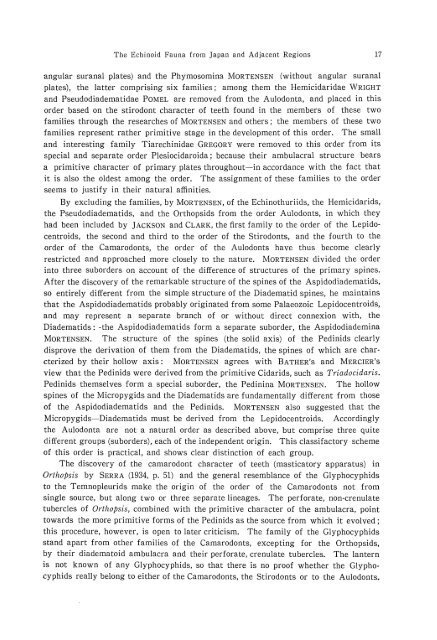the echinoid fauna from japan and adjacent regions part i
the echinoid fauna from japan and adjacent regions part i
the echinoid fauna from japan and adjacent regions part i
You also want an ePaper? Increase the reach of your titles
YUMPU automatically turns print PDFs into web optimized ePapers that Google loves.
The Echinoid Fauna <strong>from</strong> Japan <strong>and</strong> Adjacent Regions 17<br />
angular suranal plates) <strong>and</strong> <strong>the</strong> Phymosomina MORTENSEN (without angular sur anal<br />
plates), <strong>the</strong> latter comprising six families; among <strong>the</strong>m <strong>the</strong> Hemicidaridae WRIGHT<br />
<strong>and</strong> Pseudodiadematidae POMEL are removed <strong>from</strong> <strong>the</strong> Aulodonta, <strong>and</strong> placed in this<br />
order based on <strong>the</strong> stirodont character of teeth found in <strong>the</strong> members of <strong>the</strong>se two<br />
families through <strong>the</strong> researches of MORTENSEN <strong>and</strong> o<strong>the</strong>rs; <strong>the</strong> members of <strong>the</strong>se two<br />
families represent ra<strong>the</strong>r primitive stage in <strong>the</strong> development of this order. The small<br />
<strong>and</strong> interesting family Tiarechinidae GREGORY were removed to this order <strong>from</strong> its<br />
special <strong>and</strong> separate order Plesiocidaroida; because <strong>the</strong>ir ambulacral structure bears<br />
a primitive character of primary plates throughout-in accordance with <strong>the</strong> fact that<br />
it is also <strong>the</strong> oldest among <strong>the</strong> order. The assignment of <strong>the</strong>se families to <strong>the</strong> order<br />
seems to justify in <strong>the</strong>ir natural affinities.<br />
By excluding <strong>the</strong> families, by MORTENSEN, of <strong>the</strong> Echinothuriids, <strong>the</strong> Hemicidarids,<br />
<strong>the</strong> Pseudodiadematids, <strong>and</strong> <strong>the</strong> Orthopsids <strong>from</strong> <strong>the</strong> order Aulodonts, in which <strong>the</strong>y<br />
had been included by JACKSON <strong>and</strong> CLARK, <strong>the</strong> first family to <strong>the</strong> order of <strong>the</strong> Lepidocentroids,<br />
<strong>the</strong> second <strong>and</strong> third to <strong>the</strong> order of <strong>the</strong> Stirodonts, <strong>and</strong> <strong>the</strong> fourth to <strong>the</strong><br />
Drder of <strong>the</strong> Camarodonts, <strong>the</strong> order of <strong>the</strong> Aulodonts have thus become clearly<br />
restricted <strong>and</strong> approached more closely to <strong>the</strong> nature. MORTENSEN divided <strong>the</strong> order<br />
into three suborders on account of <strong>the</strong> difference of structures of <strong>the</strong> primary spines.<br />
After <strong>the</strong> discovery of <strong>the</strong> remarkable structure of <strong>the</strong> spines of <strong>the</strong> Aspidodiadematids,<br />
so entirely different <strong>from</strong> <strong>the</strong> simple structure of <strong>the</strong> Diadematid spines, he maintains<br />
that <strong>the</strong> Aspidodiadematids probably originated <strong>from</strong> some Palaeozoic Lepidocentroids,<br />
<strong>and</strong> may represent a separate branch of or without direct connexion with, <strong>the</strong><br />
Diadematids: -<strong>the</strong> Aspidodiadematids form a separate suborder, <strong>the</strong> Aspidodiademina<br />
MORTENSEN. The structure of <strong>the</strong> spines (<strong>the</strong> solid axis) of <strong>the</strong> Pedinids clearly<br />
disprove <strong>the</strong> derivation of <strong>the</strong>m <strong>from</strong> <strong>the</strong> Diadematids, <strong>the</strong> spines of which are charcterized<br />
by <strong>the</strong>ir hollow axis: MORTENSEN agrees with BATHER'S <strong>and</strong> MERCIER'S<br />
view that <strong>the</strong> Pedinids were derived <strong>from</strong> <strong>the</strong> primitive Cidarids, such as Triadocidaris.<br />
Pedinids <strong>the</strong>mselves form a special suborder, <strong>the</strong> Pedinina MORTENSEN. The hollow<br />
spines of <strong>the</strong> Micropygids <strong>and</strong> <strong>the</strong> Diadematids are fundamentally different <strong>from</strong> those<br />
of <strong>the</strong> Aspidodiadematids <strong>and</strong> <strong>the</strong> Pedinids. MORTENSEN also suggested that <strong>the</strong><br />
Micropygids-Diadematids must be derived <strong>from</strong> <strong>the</strong> Lepidocentroids. Accordingly<br />
<strong>the</strong> Aulodonta are not a natural order as described above, but comprise three quite<br />
different groups (suborders), each of <strong>the</strong> independent origin. This classifactory scheme<br />
of this order is practical, <strong>and</strong> shows clear distinction of each group.<br />
The discovery of <strong>the</strong> camarodont character of teeth (masticatory apparatus) in<br />
Orthopsis by SERRA (1934, p. 51) <strong>and</strong> <strong>the</strong> general resemblance of <strong>the</strong> Glyphocyphids<br />
to <strong>the</strong> Temnopleurids make <strong>the</strong> origin of <strong>the</strong> order of <strong>the</strong> Camarodonts not <strong>from</strong><br />
single source, but along two or three separate lineages. The perforate, non-crenulate<br />
tubercles of Orthopsis, combined with <strong>the</strong> primitive character of <strong>the</strong> ambulacra, point<br />
towards <strong>the</strong> more primitive forms of <strong>the</strong> Pedinids as <strong>the</strong> source <strong>from</strong> which it evolved;<br />
this procedure, however, is open to later criticism. The family of <strong>the</strong> Glyphocyphids<br />
st<strong>and</strong> a<strong>part</strong> <strong>from</strong> o<strong>the</strong>r families of <strong>the</strong> Camarodonts, excepting for <strong>the</strong> Orthopsids,<br />
by <strong>the</strong>ir diadematoid ambulacra <strong>and</strong> <strong>the</strong>ir perforate, crenulate tubercles. The lantern<br />
is not known of any Glyphocyphids, so that <strong>the</strong>re is no proof whe<strong>the</strong>r <strong>the</strong> Glyphocyphids<br />
really belong to ei<strong>the</strong>r of <strong>the</strong> Camarodonts, <strong>the</strong> Stirodonts or to <strong>the</strong> Aulodonts.












